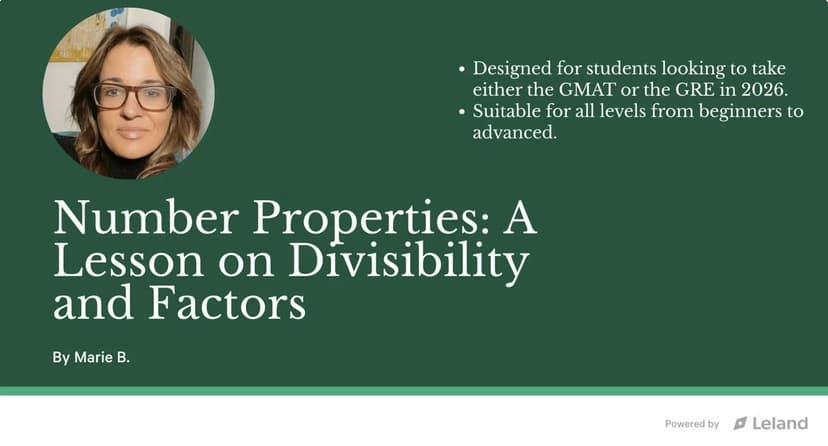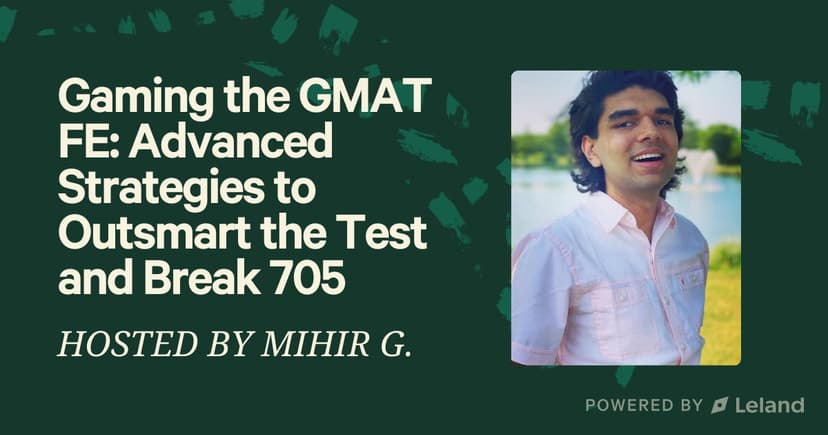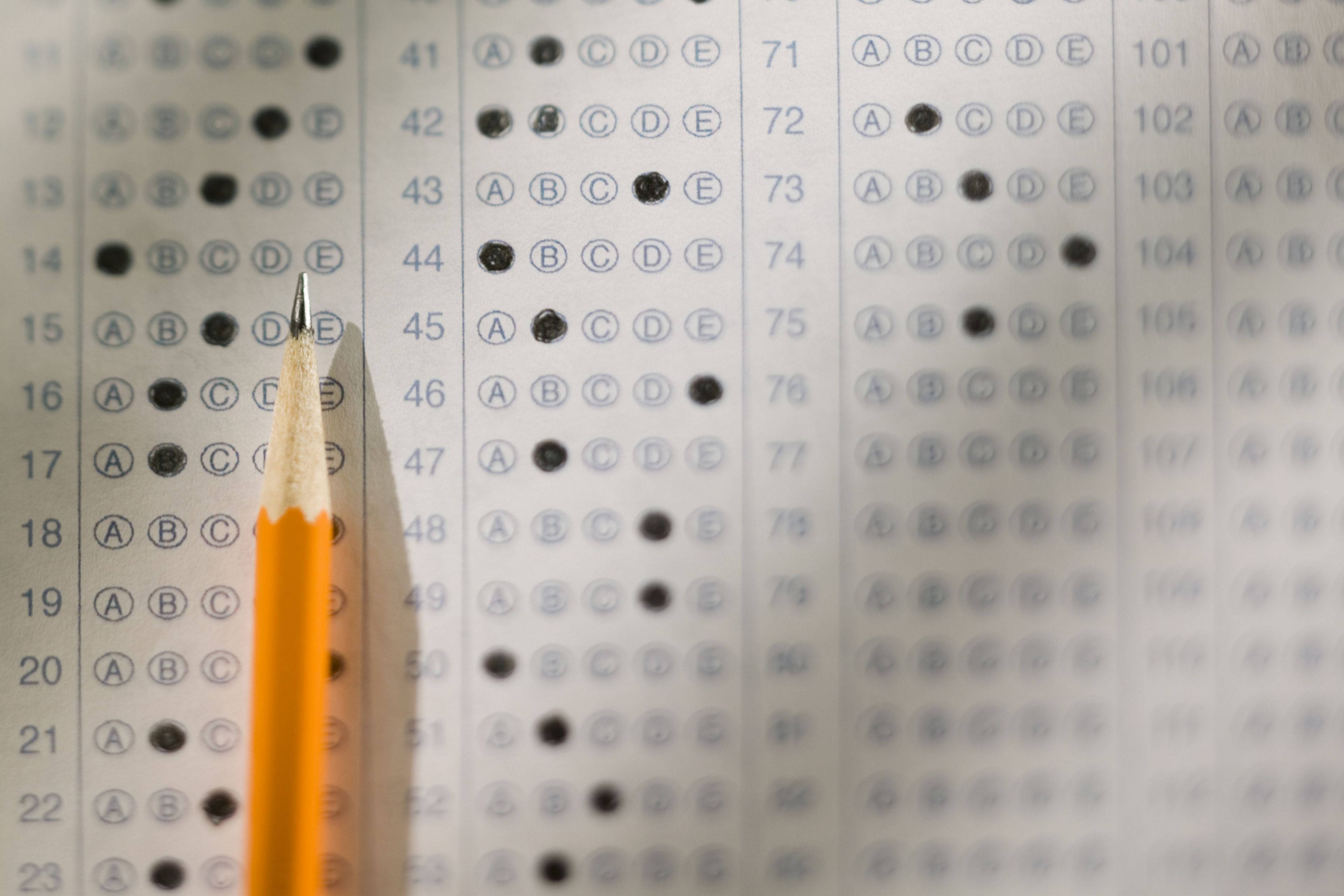
Join a free event
Learn from top coaches and industry experts in live, interactive sessions you can join for free.
Table of Contents
If you're aiming for a top GMAT quant score, there's no way around it, and you have to get comfortable with the hardest questions the test can throw at you. For most students, data sufficiency is where things really start to unravel. These problems aren’t about crunching numbers; they’re about staying sharp, thinking flexibly, and avoiding the traps hidden in deceptively simple statements.
The difference between getting a question wrong and landing the correct answer often has nothing to do with math ability and everything to do with how you approach the problem.
In this guide, we’ll break down exactly what makes data sufficiency so tricky, how to build the reasoning skills that top scorers rely on, and what real students have learned from tackling the toughest problems out there. We’ll walk through examples that test your grasp of number properties, line L, right triangles, distinct integers, and more, then show you how to prep strategically so you’re confident when it counts.
5 Hardest GMAT Questions That Trap Even Top Scorers
While “hardest” is subjective, many GMAT experts and forums converge on a few types of data sufficiency and quantitative questions that consistently stump students, even advanced ones. Below are five question types or sample challenges that tend to rank among the hardest, with notes on what makes them cruel and how to attack them.
1. Data Sufficiency with multiple hidden constraints (combinatorial or overlapping sets style)
These are often ranked in GMAT Club’s “100 Hardest DS” lists. GMAT Club The trap: the stem or statements include overlapping set conditions (e.g. A ∩ B, union, “some but not all,” “distinct integers,” “at most, at least”) and you must juggle several logical conditions simultaneously. Because multiple constraints interact, it becomes easy to miss a corner case or to misassume independence.
Example Question:
In a group of students, 70% study Math, 60% study Verbal, and 20% study both. If 10 students study neither subject, how many students are in the group?
(1) 84 students study Math.
(2) 72 students study Verbal.
Answer Analysis:
The hidden constraint is that the 20% “both” overlaps with both categories, meaning the union formula applies:
Total = M + V – Both + Neither.
Each statement alone gives partial information—you can find 70% or 60%, but not the base until combining them.
However, the trap is that the “20%” applies to total students, not to the math set or verbal set individually. Students who misapply the 20% end up with the wrong base.
Why it’s brutal: One small overlooked condition (e.g. “distinct,” “nonzero,” “not divisible by”) invalidates your scenario and flips sufficiency logic.
How to approach it: Build Venn diagrams, enumerate edge cases, and test minimal vs. maximal structure. Resist the first tempting scenario.
2. Inequalities + absolute values + sign ambiguity in DS
These appear in hard GMAT Data Sufficiency collections (e.g. “Inequalities, absolute values and number properties” in Q‑51’s hard DS bank). You might see something like: “Is x|x| = x²?” with statements that are themselves conditional or that flip sign domains.
Example Question: Is |x – 3| < x ?
Break into Cases:
Case 1: x ≥ 3
|x – 3| = x – 3
Then: x – 3 < x → always true
Case 2: x < 3
|x – 3| = 3 – x
Then: 3 – x < x → 3 < 2x → x > 1.5
So for x < 3, this is only true if x > 1.5 (not always true)
Answer Analysis:
At first glance, it seems you can just “drop” the absolute value. But that’s only valid for x > 3. If x < 3, then |x – 3| = 3 – x, and the inequality flips direction. Testing both sign regimes shows that neither statement alone guarantees the inequality, but together (x > 0 and x < 6) still allows both true and false outcomes depending on x.
Why it’s brutal: You must reason about multiple sign regimes (positive, negative, zero) and handle absolute value carefully. A misstep in sign logic causes you to treat a statement as “sufficient” when it's not.
How to approach it: Break the problem into distinct sign cases (x ≥ 0, x < 0), test boundary values, and don’t assume continuity across sign flips.
3. Geometry + line/segment partitioning in data sufficiency
GMAT’s harder quant and DS sets sometimes include geometry questions (lines, triangles, perpendicular/parallel lines) cast in DS format. In these, the line L (or another named line) and partition ratios or perpendicular segments are given in the statements. For example, Q‑51’s “right triangle” DS problems or sets where you must determine how a point divides a hypotenuse.
Example Question:
In the coordinate plane, line L passes through the origin and is perpendicular to the line passing through points (4, 0) and (0, 8). What is the equation of line L?
(1) Line L passes through (2, y).
(2) Line L passes through (x, –1).
Answer Analysis:
The original line through (4, 0) and (0, 8) has slope –2, so any line perpendicular to it has slope ½. To find the equation of L, you need both the slope (known) and one fixed coordinate. Each statement alone gives partial info (a coordinate with one variable missing), but not both x and y values together, so neither is sufficient alone. Combined, they fix a point, giving a full equation.
Why it’s brutal: You must translate between geometric relationships, segment partition formulas, and reasoning under insufficient information. It's easy to misinterpret “point divides the hypotenuse in some ratio” or assume more than given.
How to approach it: Draw clear diagrams with variables, label ratios, consider extreme placements, and test whether statements alone pin the configuration.
4. “Impossible statement” DS questions where one statement contradicts givens
This is a sneaky kind: one statement is directly incompatible with information in the stem, meaning it yields no valid scenario on its own. The correct sufficiency often hinges on spotting that inconsistency and discarding that statement.
PrepScholar calls these among the “5 hardest GMAT Data Sufficiency questions,” where knowing how to detect a contradiction is key. Also, Menlo Coaching’s discussion of official DS examples warns against picking (C) prematurely when one statement is invalid.
Question:
Is a + b even?
Key Identities:
odd + odd = even
even + even = even
odd + even = odd
From Statement 1:
a = odd, b = a + 1 → b = even
So a + b = odd → Not even
From Statement 2:
a = b → a + b = 2a → always even
Answer Analysis:
Statement (1) implies a is odd and b is even (since b = a + 1). So a+ba + ba+b = odd + even = odd → not even.
Statement (2) says a = b, so a+b=2aa + b = 2aa+b=2a, which is always even.
But together, (1) and (2) cannot both hold—if a = b, then b ≠ a + 1. The combination is impossible, meaning you must assess sufficiency individually.
Each alone is sufficient → correct answer = D.
Why it’s brutal: Many students waste time trying to force that statement or combine it incorrectly. If you don’t see the contradiction, you pick the wrong “sufficient” answer.
How to approach it: Always test each statement alone first, even if it seems obviously wrong. If it yields no valid scenario, mark it insufficient immediately and avoid carrying its info into the combined logic.
Read: GMAT Data Sufficiency: Strategy Guide, Question Types, and Pitfalls to Avoid
5. Problem Solving with multi-step logic, exponentials, probabilities, or combined concept traps
Beyond DS, in problem solving, some “hardest GMAT questions” involve layering several advanced topics: exponents, probability, combinatorics, overlapping sets, and simultaneous constraints. Magoosh collects “challenging quant practice questions” that reflect this layering.
Example Question:
A box contains 3 red balls and 2 blue balls. Two balls are drawn without replacement. What is the probability that at least one is red?
Answer Analysis:
Compute complement: probability that none are red = both blue.
P(both blue) = (2/5) × (1/4) = 2/20 = 1/10.
Therefore, P(at least one red) = 1 – 1/10 = 9/10.
The setup is easy, but the GMAT twists it by nesting multiple probabilities or asking for “at least” logic that forces you to think inversely.
Why it’s brutal: You might need to:
- Translate wordy statements into algebra
- Use combinatorial logic + probability
- Maintain consistency across multiple constraints
- Avoid intermediate rounding traps or misorder of operations
One misstep in logic or algebra early on breaks everything.
How to approach it: Break the problem into modular “mini sub‐questions,” plug in test values when possible (backsolving), and always check whether your chosen path violates a constraint you overlooked.
For more insights on GMAT problem-solving questions, read:
- GMAT Focus Rate Problems: Tips & Practice
- GMAT Focus Word Problems: Tips & Practice
- GMAT Focus Verbal: Topics, Timing, Scores, & Tips
- GMAT Focus Quant: Topics, Timing, Scores, & Tips
Real Voice from Students: “These are the ones I freeze on”. On Reddit, one user reflected on doing the “hardest 100 quant questions”:
“When I try the 700+ level questions, 50% of the time I don’t even know what they’re asking… practicing those problems I do not believe will help you.”
This feedback underscores that difficulty often comes from ambiguity, not numbers. Your challenge is to make ambiguity your friend by always testing alternate interpretations and avoiding assumptions.
Quick Shortcuts for the Hardest GMAT Question Types
| Question Type | Shortcut or Strategy |
|---|---|
| Overlapping Sets | Use the union formula: Total = A + B – Both + Neither |
| Inequalities + Absolute Value | Always break into sign cases (positive, negative, zero) |
| Geometry Line/Segment | Draw + use midpoint/slope logic; don’t assume without coordinates |
| Contradictory Statements in DS | If a statement creates an impossible scenario, mark it invalid |
| Hard Problem Solving | Work backward (plug in), look for complement probability, test edge values |
Why Data Sufficiency Is the “Great Equalizer” on GMAT
GMAC (the test makers) structures data sufficiency not to test crazy math, but to test your reasoning, attention to additional information, and ability to think through ambiguous setups.
In difficult DS problems:
- The most relevant difficulty lies in logic and phrasing, not raw algebra.
- The test writers embed traps or “cons” that your initial impulse might miss.
- The question stem often hides the key constraints you must leverage before even reading the statements.
- Many students under‑leverage or over‑leverage statements (i.e. carry info between statements, assume things they shouldn’t).
In short, DS is a battlefield of vigilance, not brute force. It’s often a better differentiator of elite scorers than “hardest problem-solving” questions.
Read: GMAT Sections Guide: What’s Tested and How to Prepare
What Students Say: Lessons from Reddit and GMAT Club
Real voices from forums reveal what’s painful, what’s misused, and what actually helps.
From Reddit: the “100 hardest quant questions” trap
One user wrote:
“When I try the 700+ level questions, 50% of the time I don’t even know what they’re asking… practicing those problems I do not believe will help you.”
That’s a warning: overdoing “hardest 100” blindly can lead to frustration. The key is selective, purposeful practice, not brute force. Many users report that they rarely see those extreme questions on the actual test day.
Another thread:
“On TTP, I rarely make silly mistakes and am averaging around 60‑65% [on their hardest quant] vs 85% on official practice.”
This suggests that some prep sources distort difficulty; use them to train mindset, but take them with a grain of salt.
From GMAT Club: “Getting crushed by DS”
One thread from a user aiming at 630–650:
“Data sufficiency is contributing a significant amount to the variance in my score… success rate with data sufficiency questions is less than 50%.”
In replies, experienced users advise:
- Revisit number properties, algebra, fractions, inequalities, geometry, and probability — DS draws from all those.
- Practice reading the question stem and enumerating every possible case.
- Build the habit of “if this, then that; if not, the other” reasoning.
Takeaway: The people who miss in DS often misread the stem, miss hidden constraints, or fail to explore edge cases. You must be more rigorous.
The Framework: How to Solve the Hardest GMAT Data Sufficiency Questions
Here is a step‑by‑step method that elite scorers use to systematically handle the hardest DS problems.
| Step | What to Do | Why It Matters |
|---|---|---|
| 1 | Read and restate the question stem before looking at statements. Clarify exactly what is being asked (value? yes/no? inequality?) | Many traps depend on subtleties in the stem, not the statements. |
| 2 | List all explicit constraints. (e.g. “distinct integers”, “positive”, “nonnegative”, “line L is perpendicular”, etc.) | If you miss one, you may accept an invalid scenario. |
| 3 | Identify key variables and relationships; draw a diagram if geometry or a number line is involved. | Visuals help reduce mistakes, especially for line, right triangle, or distance on number line setups. |
| 4 | Consider extreme or corner cases (e.g. minimum, maximum, equal, overlap). | Many DS traps reveal themselves via edge cases. |
| 5 | Evaluate Statement (1) ALONE for sufficiency: prove or find two valid scenarios (yes/no or different values). | Do not assume info from statement (2). |
| 6 | Evaluate Statement (2) ALONE similarly (without using Statement 1). | Same discipline. |
| 7 | Test Statements (1 + 2) together. If now exactly one answer emerges in all cases, it’s sufficient. | Be careful to avoid combining them in a way that “smuggles in” extra assumptions. |
| 8 | Do a final sanity check to ensure no overlooked cases or flawed logic. | Many “correct answers” were wrong because a rare scenario was ignored. |
Important rules to internalize:
- Don’t carry information forward from statement 1 into statement 2.
- Always question your assumption (“Is that always true? Could it be false?”).
- Don’t settle early, just because a statement seems sufficient, push to find a counterexample if possible.
- Spot the “con”: if something seems “too easy” or magic, there’s likely a trap.
This framework is what you’ll use in the worked examples below.
Worked Examples of the Hardest GMAT Questions
Below are two heavy examples that combine multiple themes: number properties, algebra, line, right triangle, and distinct integers. Each shows how a strong framework wins.
Example 1: Number line + distances (line L scenario)
Question (restated):
Points A, B, and C lie on a line L (i.e. on the same number line). If the distance between A and B is 10, and the distance between B and C is 6, what is the distance between A and C?
(1) A is to the left of C (i.e. A < C)
(2) B is the midpoint between A and C
Is the information sufficient?
Step 1 – Stem & constraints
- We seek distance AC, which is |A – C|.
- Distances are nonnegative.
- Points lie on the same line.
Step 2 – Given info diagram
You can draw a line and place B, then possibilities:
- A — B — C
- B — A — C
- A — C — B
Distance AB = 10, BC = 6.
Step 3 – Evaluate (1) alone
(1) says A < C, i.e. A is to the left of C, but we don’t know relative ordering with B. Possible placements:
- If A — B — C: then AC = AB + BC = 10 + 6 = 16
- If B — A — C: then B is left of A, then C right, but distances still plausible: B to A = 10, B to C = 6 → A and C are 16 apart again (but reversed).
- If A — C — B cannot happen if A < C because B would be to the right of C.
Actually, all valid possibilities yield AC = 16. So statement (1) is sufficient. (No ambiguity).
Step 4 – Evaluate (2) alone
(2) says B is the midpoint of A and C, so AB = BC. But given AB = 10, BC = 6—they are unequal. That situation is impossible. Thus (2) is inconsistent with the givens; in real DS logic, we treat it as insufficient (or invalid).
Conclusion: Statement (1) alone suffices → the correct answer = A (only (1) is sufficient).
Lesson: Even something as geometric as “line L” problems requires rigorous enumeration of possible orderings, not assumptions.
Example 2: Two statements with distinct integers + algebra + inequalities + right triangle
Question (restated):
Let x and y be distinct positive integers. Consider whether the triangle with side lengths x, y, and 10 is a right triangle.
(1) x2+y2=100x^2 + y^2 = 100x2+y2=100
(2) x+y>12x + y > 12x+y>12
Is there enough information to determine whether such a triangle is right (i.e. satisfies Pythagoras)?
Step 1 – Stem & constraints
- Right triangle means (some permutation):a2+b2=c2\text{(some permutation)}: a^2 + b^2 = c^2(some permutation):a2+b2=c2.
- x, y, 10 are side lengths. The hypotenuse may be 10, or x or y (if greater).
- x and y are positive, distinct integers.
Step 2 – Start with statement (1) alone
x2+y2=100x^2 + y^2 = 100x2+y2=100.
Find integer solutions prior to considering (2):
Possible pairs: (6, 8) or (8, 6) match 36 + 64 = 100.
- If x = 6, y = 8, or vice versa.
Then the triangle sides are (6, 8, 10). That is a right triangle (6^2 + 8^2 = 100)
Is there any other distinct integer pair? No (3, √91) isn’t an integer. So (1) determines exactly one pair.
Thus, (1) alone is sufficient to assert that the triangle is right.
Step 3 – Statement (2) alone
x+y>12x + y > 12x+y>12. Many pairs satisfy: (7, 6), (8, 5), (9, 5), etc. Those might or might not form right triangles with side 10. So (2) is insufficient.
Thus answer would be A again (only statement 1 is sufficient).
Lesson: Hidden among the algebra is the assumption that only integer solutions matter, and that the candidate must match the right triangle condition. This becomes a cleaner DS example combining number properties, algebra, and geometry.
How to Practice & Improve Before Test Day
The difference between scoring in the 600s and hitting a 700+ quant score isn’t just content knowledge; it’s how deliberately you train. Mastering the hardest GMAT questions requires more than brute-force problem sets or endless scrolling through forums. You need a methodical, high-yield approach that builds clarity, flexibility, and accuracy under pressure. Here's how top scorers sharpen their edge.
Create a Balanced, Targeted Practice Bank
Don’t fall into the trap of blindly grinding through “100 hardest” lists. The goal isn’t to exhaust yourself, it’s to expose yourself to high-quality, pattern-rich questions that stretch your thinking in the right ways. Each day, work through one or two truly difficult data sufficiency problems alongside carefully selected problem-solving questions.
Prioritize topics that appear most often in hard questions: number properties, inequalities, probability, and algebra. Use official GMAT problems whenever possible, or trusted sources like Manhattan, GMAT Club’s tagged questions, and the OG. What matters isn’t quantity, it’s depth and intentionality.
Study the Anatomy of Every Mistake
After solving each question, don’t move on. Reverse engineer it. What was the trap? Did you fall for a false sufficiency? Overlook an edge case? Assume something that wasn’t stated? Top scorers treat every miss as a lesson. Build the habit of conducting a 60-second “post-mortem” on every question you attempt, especially the ones you got right but guessed on. Over time, you’ll develop an internal radar for patterns and pitfalls that GMAC loves to test.
Train for Logic First, Then Speed
Time pressure matters, but only if your logic is airtight. Many students mistakenly rush through practice sets in an effort to mimic exam conditions, but in doing so, they reinforce sloppy habits. At this stage, slow is smooth, and smooth becomes fast. Focus first on thinking clearly, not quickly. If your process is rock solid, your speed will follow. As one Reddit user put it: “Slowing down is what got me from 85% to 100% accuracy in Quant.”
Push Yourself Occasionally With “Hard Mode”
To simulate the mental fatigue and ambiguity of a real test day, occasionally challenge yourself with a short, high-difficulty set under strict timing. One or two “ultra-hard” questions at the end of a study session can sharpen your endurance and force you to think clearly under pressure. But don’t overdo it; daily burnout from constant extremes is counterproductive. The goal is to build confidence, not erode it.
Calibrate Back to Official Test Difficulty
As test day approaches, shift your focus back to the GMAT’s actual difficulty curve. Many users report that prep platforms like TTP or hard forum questions tend to be more abstract or calculation-heavy than what you’ll face on the real thing. In the final week, use Official Guide problems, GMAC mock exams, or the Quantitative Review book to recalibrate your instincts. You want your test-day radar to be tuned for official logic, not artificial difficulty.
Read: GMAT Study Tips From Pro Tutors: From 600 to 700+ and How Long Should You Actually Study for the GMAT Focus Edition?
Key Takeaways & Final Tips
- The hardest GMAT questions, particularly in data sufficiency, test your reasoning, not raw calculation.
- Always read the stem first, list constraints, draw diagrams, and test edge cases.
- Use a disciplined framework to evaluate each statement alone, then together.
- Real-world insights from Reddit and forums emphasize that careless practice of “hardest 100” may hurt more than help.
- In your prep, mix hard DS and problem solving; deconstruct every mistake; and finish with official-caliber difficulty.
Final Thoughts: Mastery Comes From Method, Not Just Math
The hardest GMAT questions, especially in data sufficiency, aren’t designed to test how much math you know. They test how well you think. Success isn’t about memorizing more formulas or grinding through every “700+” problem you can find. It’s about training your brain to spot patterns, reason through ambiguity, and stay calm under pressure. The students who excel are the ones who know how to practice, what to look for in each question, and why certain answers are right, beyond just getting them correct.
If you’re serious about breaking into the top quant percentiles, don’t try to do it all on your own. Leland coaches include former 760+ scorers, ex-McKinsey consultants, TTP veterans, and data sufficiency nerds who can show you exactly how to think, practice, and improve faster. Whether you're stuck at a plateau or aiming for a final score boost before test day, we’ll match you with someone who’s been where you are and knows how to help you break through.
Book a free intro call with a GMAT Quant coach on Leland and take the guesswork out of your prep. Also, join GMAT test prep bootcamps and free events for more strategic insights!
Read next:
- GMAT Focus Sections: Overview & Structure Breakdown
- How Long is the GMAT (Focus Edition)? Breakdown by Section & Total
- 3 Things You Need to Know About the New GMAT Focus Edition
- GMAT Focus Score Chart — With Percentiles
- How Late Can You Take the GMAT/GRE for MBA Applications
- GMAT Math Questions: 5 Best Places to Go for Quant Practice
FAQs
What are the hardest types of questions on the GMAT?
- The toughest GMAT questions are usually advanced data sufficiency problems that involve logic traps, inequalities, number properties, or overlapping constraints. Problem-solving questions that combine algebra, probability, and multiple steps can also rank among the most difficult, especially when they require interpreting abstract wording or avoiding false assumptions.
How do I get better at GMAT data sufficiency questions?
- Getting better at DS means training your logic, not just your math. Start by practicing how to read the stem carefully, test edge cases, and evaluate each statement separately. Focus on spotting when a statement gives just enough info, or not quite enough. After each question, break down what made it tricky and how you'd approach it differently next time.
Should I practice the hardest GMAT questions or focus on accuracy first?
- Focus on accuracy first. If you’re still missing medium-difficulty questions, grinding through the hardest problems can backfire. But once you’re consistently scoring well, adding a few hard questions to your practice each day can help sharpen your logic and prepare you for test-day surprises, just don’t overdo it.
How hard are the GMAT’s hardest quant questions compared to practice ones?
- It depends on the source. Some prep platforms (like TTP or GMAT Club) include questions that are harder than what you’ll see on the real test, more abstract, or calculation-heavy. The actual GMAT is tricky in a more subtle way. It tests logic, precision, and efficiency under pressure, not just raw math skills.
How do I know if I’m ready for 700+ level GMAT quant questions?
- If you’re consistently scoring 80%+ on official medium and hard questions, finishing sections on time, and understanding why each answer is right or wrong, you're on the right track. The next step is learning how to stay composed when a hard DS question throws you off, because 700+ scoring is as much about mindset and method as it is about knowledge.
Browse hundreds of expert coaches
Leland coaches have helped thousands of people achieve their goals. A dedicated mentor can make all the difference.



















